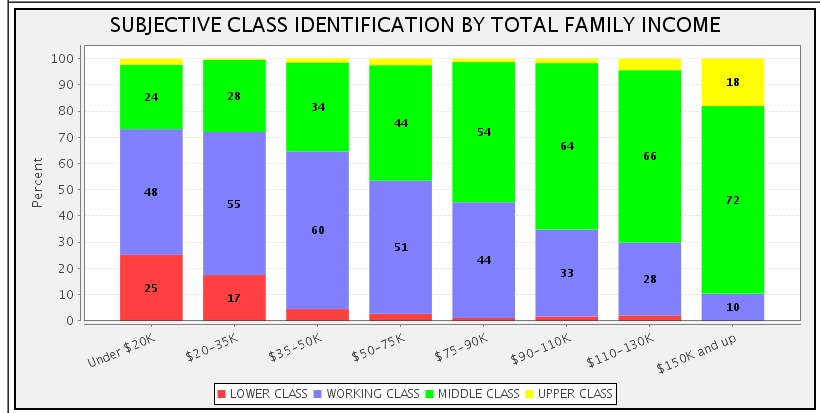February 21, 2014
Paul Krugman recently highlighted Pew’s finding that the share of Americans identifying as “middle class” (44 percent) has nearly converged with the total share identifying as either lower-middle (28 percent) or lower class (12 percent). This sounds totally plausible, but got me wondering where “working class” self-identification fits in.
Pew doesn’t include working class as an option in its survey, but the long-running General Social Survey (GSS) includes both working class and lower class as options. In the chart below, I use the GSS to track class identification between 1980 and 2012 (the most recent year for which GSS data is available). As it shows, at 44 percent, the share of Americans identifying as working class in 2012 was the same as the share identifying as middle class. Only about 8 percent of Americans identified as lower class, slightly higher than the roughly 5 percent on average who identified as lower class before the Great Recession.

Source: Author’s tabulation of data from General Social Survey (1980-2012).
The fact that as many Americans self-identify as working class as do middle class is striking given how uncommon the term working class seems to be in both the media and political speech these days. This is the case not only when compared to the nearly ubiquitous term middle class, but also when compared to seemingly disfavored ones like the poor and poverty. For example, when I searched the New York Times over the last 12 months, I got back three and a half times as many results using the term “poverty” (10,600) as I did when using the term “working class” (2,950).
Similarly, articles mentioning both the middle class and the poor were much more common in the Times over the last year than ones referencing both the middle class and the working class.
A related issue involves the extent to which the actual working class is still often conflated in media and political discourse with the “white working class.” In both the media and politics, the face of the working class is often that of a retired white factory worker living in a swing state, while low-income people of color, single mothers, and others who don’t fit the conventional paradigm of the working class are more typically described as poor or lower class.
But as the figure below shows, even those in the lowest income group (here under $20,000) typically identify in class terms as working class (and as middle class as often as they do lower class).
Moreover, working class identification among white, non-Latinos is much lower than it is among blacks and Latinos. For example, as the table below shows, black women much more likely to identify as working class than white, non-Hispanic men (56% vs. 40%).

In short, both the media and politics need to catch up with how Americans really think of themselves in class terms, and do a better job of representing the diverse nature of today’s near-majority working class.
PS: For an excellent in-depth discussion of class identification in the United States as of the mid-2000s, see this paper by Berkeley’s Michael Hout and the Russell Sage volume Social Class: How Does It Work?.







